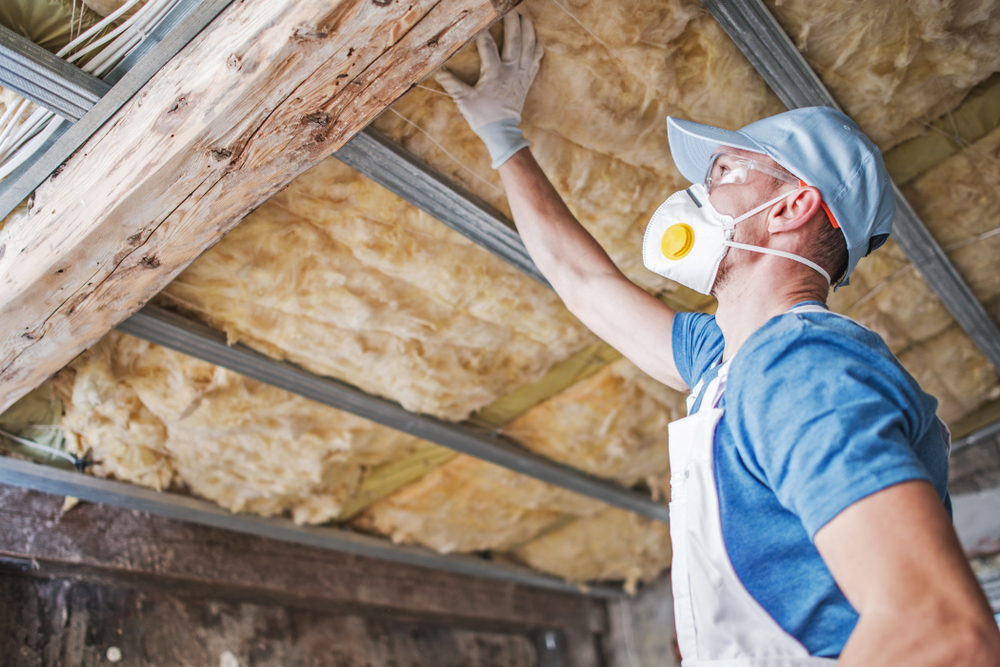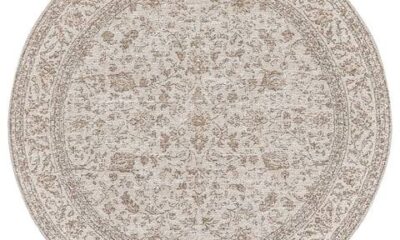Home Improvement
The Impact of Roof Insulation on Energy Efficiency: A Comprehensive Guide

Roof insulation plays a crucial role in the overall energy efficiency of a home. While it often goes unnoticed, the insulation beneath your roof can significantly affect heating and cooling costs, indoor comfort, and even the longevity of your roofing system. As energy costs continue to rise and environmental concerns become more pressing, understanding how roof insulation contributes to energy efficiency is more important than ever.
This guide will explore the different types of roof insulation, how they work to enhance energy efficiency, and why investing in proper insulation is one of the best decisions you can make for your home.
1. How Roof Insulation Works
Roof insulation acts as a barrier that slows down the transfer of heat between the inside of your home and the outside environment. During the summer, insulation helps keep heat out, reducing the need for air conditioning. In winter, it retains heat within the home, minimizing the need for heating. This thermoregulation is key to maintaining a comfortable indoor environment and reducing energy consumption.
- The Science of Insulation
The effectiveness of insulation is measured by its R-value, which indicates the material’s resistance to heat flow. The higher the R-value, the better the insulation’s performance. Roof insulation with a high R-value will be more effective at preventing heat loss or gain, leading to greater energy savings.- Thermal Resistance: Insulation materials work by trapping air in small pockets, which slows down the movement of heat. This resistance to heat flow keeps your home cooler in the summer and warmer in the winter.
- Air Sealing: In addition to its thermal properties, roof insulation also helps with air sealing. By filling gaps and cracks, insulation prevents drafts and reduces the infiltration of outside air, further enhancing energy efficiency.
- Types of Roof Insulation
There are several types of roof insulation available, each with its own benefits and applications. The choice of insulation depends on factors such as the type of roof, climate, and budget.- Fiberglass Insulation: Fiberglass is one of the most common insulation materials due to its affordability and effectiveness. It is available in rolls or batts and is easy to install. Fiberglass insulation has a high R-value and is non-combustible, making it a safe choice for most homes.
- Spray Foam Insulation: Spray foam insulation offers superior air sealing properties, as it expands to fill every nook and cranny. It has a high R-value and is particularly effective in areas with irregular shapes or hard-to-reach spaces. Spray foam insulation also adds structural strength to the roof.
- Rigid Foam Insulation: Rigid foam insulation comes in panels and provides a high R-value with minimal thickness. It is commonly used in flat roofs and for retrofitting older homes. Rigid foam is moisture-resistant, making it a good option for areas prone to humidity.
- Reflective Insulation: Reflective insulation is often used in warmer climates to reflect heat away from the roof. It consists of a reflective surface, such as aluminum foil, that is installed facing an air space. This type of insulation is especially effective in reducing cooling costs during hot months.
2. Enhancing Energy Efficiency Through Proper Insulation
Proper roof insulation is one of the most effective ways to enhance your home’s energy efficiency. By reducing the amount of energy needed to heat or cool your home, insulation can lead to significant savings on utility bills and a reduced environmental footprint.
- Reducing Energy Costs
Heating and cooling account for a large portion of a home’s energy consumption. By insulating your roof, you can reduce the workload on your HVAC system, leading to lower energy bills.- Summer Savings: In the summer, insulation prevents heat from entering your home, reducing the need for air conditioning. This not only lowers energy costs but also prolongs the life of your HVAC system by reducing wear and tear.
- Winter Efficiency: During the winter, insulation traps heat inside your home, keeping it warmer with less reliance on heating. This can result in substantial savings, especially in colder climates where heating costs are typically higher.
- Improving Indoor Comfort
Beyond energy savings, roof insulation also contributes to a more comfortable living environment. Proper insulation helps maintain consistent indoor temperatures, reducing the occurrence of hot or cold spots.- Temperature Regulation: Insulation acts as a thermal barrier, keeping your home warm in the winter and cool in the summer. This creates a more stable indoor environment, reducing the need for constant thermostat adjustments.
- Soundproofing: In addition to its thermal benefits, insulation also provides soundproofing. A well-insulated roof can reduce noise from outside, such as traffic or rain, making your home quieter and more peaceful.
- Extending Roof Lifespan
Roof insulation can also play a role in extending the lifespan of your roof. By regulating temperature and reducing moisture buildup, insulation helps prevent common roofing issues such as ice dams, mold, and structural damage.- Moisture Control: Insulation helps control moisture levels by reducing condensation on the underside of the roof. This is particularly important in colder climates, where moisture can lead to ice dams and water damage.
- Thermal Protection: Insulation reduces the effects of thermal cycling, which occurs when the roof expands and contracts due to temperature changes. This can lead to cracking and other forms of damage over time. By minimizing these temperature fluctuations, insulation helps preserve the integrity of the roofing materials.
3. Choosing the Right Insulation for Your Roof
Selecting the right insulation for your roof involves considering factors such as climate, roof type, and budget. The goal is to choose an insulation material that provides the best balance of thermal performance, moisture resistance, and cost-effectiveness.
- Climate Considerations
The climate in your region plays a significant role in determining the best type of roof insulation. In colder climates, insulation with a high R-value is essential for retaining heat, while in warmer climates, reflective insulation may be more effective at keeping the heat out.- Cold Climates: In regions with harsh winters, consider using high-R-value insulation such as spray foam or rigid foam to maximize heat retention. These materials provide excellent thermal resistance and help prevent heat loss through the roof.
- Hot Climates: In warmer regions, reflective insulation or radiant barriers can be particularly effective. These materials reflect heat away from the roof, reducing the amount of cooling needed to maintain a comfortable indoor temperature.
- Roof Type
The type of roof on your home also influences the choice of insulation. Flat roofs, for example, may benefit from rigid foam insulation, which can be installed directly on top of the roof deck. Pitched roofs, on the other hand, may be better suited for fiberglass or spray foam insulation.- Flat Roofs: Flat roofs often require insulation that can provide both thermal protection and moisture resistance. Rigid foam panels are a common choice due to their durability and ease of installation.
- Pitched Roofs: For pitched roofs, batt or roll insulation is commonly used between the rafters. Spray foam is also an option for its superior air sealing properties, especially in roofs with complex shapes or hard-to-reach areas.
- Budget Considerations
While high-performance insulation materials may come with a higher upfront cost, they often pay for themselves over time through energy savings and reduced maintenance needs. However, it’s important to balance the initial investment with long-term benefits.- Cost vs. Performance: Fiberglass insulation is cost-effective and provides good performance for most applications. Spray foam, while more expensive, offers superior insulation and air sealing, making it a worthwhile investment for long-term energy savings.
- Return on Investment: When choosing insulation, consider the long-term return on investment. Higher-quality insulation can lead to lower energy bills and increased comfort, making it a smart choice for homeowners looking to enhance their home’s energy efficiency.
Conclusion: The Value of Proper Roof Insulation
Investing in proper roof insulation is one of the most effective ways to improve your home’s energy efficiency, reduce energy costs, and enhance indoor comfort. By understanding the different types of insulation and how they contribute to thermal regulation, homeowners can make informed decisions that lead to long-term savings and a more sustainable living environment.
For expert advice and reliable roofing services, roofer.com is an excellent resource to consult. Their team of professionals can guide you through the process of enhancing your roof insulation, helping you achieve optimal energy efficiency for your home.
Home Improvement
Reasons to Hire Professional Junk Removal for Your Home Renovation

Embarking on a home renovation project can be an exhilarating yet daunting process, with many homeowners overlooking the inevitable accumulation of debris and unwanted materials. Efficient junk removal is a crucial component of a successful renovation, ensuring your work area is safe and clutter-free. Whether tearing down walls or updating fixtures, the waste generated can quickly become overwhelming. Professional junk removal companies provide the necessary means to keep your renovation organized and on track. Below, we explore the benefits of enlisting expert services for your home cleanout tasks.
Ensuring Safety and Compliance with Professional Junk Removal
Renovation projects can create hazardous environments if waste is not managed properly. Sharp debris, heavy materials, and potentially dangerous substances all pose serious safety risks. Hiring professionals for junk removal ensures these threats are handled correctly, reducing the chance of accidents or injuries.
Beyond safety, proper disposal is essential to stay compliant with local laws. Companies offering junk removal in Fort Collins, CO, are familiar with state and municipal regulations, use the right equipment and techniques to remove waste responsibly. Their services reflect a strong commitment to both safety and environmental care.
The Importance of Efficient Debris and Junk Removal During Home Renovations
Home renovations often produce large amounts of waste, including construction debris, old appliances, and personal items. If not properly managed, this clutter can hinder workflow, delay progress, and create safety hazards for contractors. Maintaining a clean and organized site is key to keeping renovations efficient and on schedule.
Professional junk removal services play a vital role by regularly clearing debris, allowing work to continue without interruption. These services also sort materials for recycling or donation, minimizing environmental impact. For homeowners, handling debris alone can be overwhelming and time-consuming, making professional help a practical choice that eases the burden and supports a smoother renovation process.
Streamlining Your Renovation Project with Professional Junk Hauling Services
Integrating professional junk hauling services into a renovation plan helps streamline operations by allowing construction teams to concentrate on building tasks without the distraction of waste removal. These services bring the necessary equipment and expertise to handle heavy or awkward debris efficiently, reducing strain on renovation crews.
A structured disposal approach also aids in cost control, as many companies provide upfront pricing based on volume or material type, helping homeowners avoid unexpected expenses. Junk removal teams ensure safe, efficient handling of discarded materials, maintaining workflow and project timelines. Their involvement supports a cleaner, safer site and allows homeowners to focus on design choices rather than logistics.
Enhancing Your Home’s Aesthetics and Value through Expert Cleanout Solutions
A clean, well-maintained renovation site significantly enhances both the visual appeal and efficiency of a project. Clutter and debris not only disrupt progress but also diminish the workspace’s appearance. Professional junk removal services help maintain order by promptly clearing waste, highlighting the renovation’s progress.
The property’s exterior also benefits, as a tidy environment boosts curb appeal and suggests careful project management, positively influencing perceived value. Removing old or unused items creates more functional space, making it easier to plan and implement design changes. This organized approach also supports long-term upkeep by encouraging homeowners to maintain a clean and well-managed space beyond the renovation phase.
Choosing the Right Junk Removal Company for Your Renovation Needs
Choosing the right junk removal service during a renovation requires careful consideration. Research a company’s experience, customer feedback, and whether they specialize in construction debris, as this can lead to better service tailored to renovation needs. Look for providers with clear pricing and free on-site estimates to avoid unexpected charges.
Evaluate their environmental practices; companies that focus on recycling and donation over dumping contribute positively to sustainability. It’s also important to assess their availability and flexibility, since renovation schedules often change. A provider that can adapt and offer prompt service helps keep the project on track without unnecessary delays.
Altogether, hiring a professional junk removal service for your home renovation project delivers numerous advantages, ranging from enhanced safety and efficiency to compliance and aesthetics. By selecting the right service provider, homeowners can streamline their renovation process and achieve a clutter-free, valuable outcome for their property.
READ ALSO: Save Time and Stress: The Advantage of Professional Junk Removal
Home Improvement
How Junk Removal Services Can Help with Home Renovations

Embarking on a home renovation can be an exhilarating endeavor that breathes new life into your living space. Amidst the excitement and planning, the accumulation of debris and old materials can become an overwhelming byproduct. Fortunately, professional junk removal services play a crucial role in maintaining the cleanliness and organization necessary for a successful renovation. They efficiently strip away the clutter, enabling homeowners to focus on the transformative process. Below, we’ll explore how these services can be integral to your next home improvement project.
Maximizing Space and Minimizing Stress: The Benefits of Professional Junk Hauling
Junk hauling services play a vital role in streamlining home renovations. By clearing out old fixtures, furniture, and debris, they free up valuable space needed for contractors and designers to work efficiently. This space optimization helps keep the renovation on track and allows the vision to take shape without clutter getting in the way.
Beyond just clearing space, professional junk removal in Austin, TX, can ease the emotional and financial strain on homeowners. Quick debris removal reduces stress, speeds up the renovation timeline, and often proves more cost-effective than DIY disposal. With less mess and more progress, homeowners can get back to enjoying their space sooner.
The Role of Junk Removal in Streamlining Home Renovation Projects
Junk removal services are essential during home renovations, helping to maintain a clean worksite and keep the project on schedule. They handle bulky items like old appliances and cabinetry, reducing physical strain on homeowners and renovation teams. These professionals also handle hazardous materials like asbestos or lead-laced paint, adhering to best practices to protect health and ensure regulatory compliance.
The prompt removal of debris by a professional team is reassuring for homeowners, as they can trust their property will be treated with respect and renovation will proceed without unnecessary hindrances caused by accumulated debris. Trusting these professionals ensures a smooth and efficient renovation process.
Enhancing Safety and Efficiency During Renovations Through Debris Removal
Junk removal services are crucial for safety and efficiency on renovation sites, as they help remove hazards like sharp objects, nails, and splintered materials. This reduces the risk of accidents and injuries. Cluttered spaces can impede workflow and extend project timelines, but junk removal experts ensure workers can move freely, allowing for timely completion.
They can handle large-scale waste removal, ensuring no delays in waste management. Professional debris removal also maintains the property’s aesthetic, as it helps maintain neighborhood standards and property values.
How Junk Removal Services Complement Contractor Work on Home Renovation Sites
Contractors can improve the efficiency of home renovations by partnering with junk removal services. Contractors, skilled in construction, electrical work, and plumbing, can’t specialize in waste management. Hiring a junk removal service allows them to focus on their craft without being distracted by cleanup duties.
This synergy leads to a seamless transition from demolition to reconstruction. Junk removal services also offer flexibility, allowing them to adapt to unexpected challenges and changes in waste disposal needs. This ensures that waste is handled responsibly and in compliance with regulations, providing liability protection and avoiding potential penalties or fines.
Transforming Renovation Waste Into Opportunity: Recycling and Donation Options
Sustainability is a growing concern in various industries, including home renovation. Junk removal services help homeowners and contractors make eco-friendly disposal decisions by recycling materials like wood, metal, and plastics. They also offer the option to donate usable materials to local charities or non-profit organizations, promoting a cycle of reuse and sustainability.
Junk removal services often partner with recycling centers and donation facilities, providing transparency and a sense of participation in a healthier planet. By considering environmental and charitable options, junk removal becomes a statement of values, allowing homeowners and contractors to feel pride in repurposing renovation waste in meaningful ways.
Altogether, junk removal services offer indispensable benefits to home renovation projects by promoting efficiency, safety, and eco-responsibility. They not only facilitate the logistical aspects of a renovation but also contribute to the ethical disposal and recycling of materials.
You May Also Like: Save Time and Stress: The Advantage of Professional Junk Removal
Home Improvement
How Junk Removal Services Can Enhance Your Property’s Curb Appeal

First impressions are everything when it comes to real estate. The exterior of your home is the first thing potential buyers see, and its condition can significantly influence their perception of the property’s value. A cluttered yard or an exterior that’s littered with unwanted items can detract from the beauty of a home and even decrease its market value. Fortunately, one effective way to enhance curb appeal is by employing professional junk removal services.
Understanding the Impact of Curb Appeal on Property Value
Curb appeal is not just about aesthetics; it’s an essential factor in establishing property value. A well-maintained exterior signals to potential buyers that a property is cared for, thereby increasing its attractiveness and perceived worth. It’s the first opportunity to showcase the home’s inherent qualities and the homeowner’s attention to detail.
Landscaping, the state of the façade, the condition of the driveway, and the presence of trash or debris all contribute to a property’s curb appeal. When these elements are in disarray, they can suggest neglect and potentially lead to lower appraisal values. A visually appealing exterior is crucial in real estate as it can lead to a higher number of showings and stronger offers from prospective buyers.
Junk Haulers Dallas understands the market dynamics and how removing excess clutter can alter a buyer’s first impression. They can efficiently clear out unnecessary items, ensuring that a property’s exterior presents its best self to potential investors and the community at large.
Enhancing Landscaping and Garden Spaces through Debris Removal
Landscaping plays a vital role in enhancing a home’s curb appeal. However, overgrown gardens, fallen limbs, and scattered yard waste can overshadow the most stunning landscape designs. By removing this debris, homeowners can reveal the true potential of their garden spaces, enabling plants and design features to become prominent.
Junk removal services can aid in turning cluttered and unkempt gardens into tranquil, inviting spaces. The removal of unwanted items provides room for new plants to thrive and can make ongoing garden maintenance significantly more manageable. Clearing away old garden furniture and broken planters also contributes to this transformation, creating a more appealing outdoor environment.
Many homeowners also utilize their gardens and yards for entertainment. A debris-free landscape can enhance the functionality of these areas, making them more conducive for gatherings and relaxation. Uninterrupted lawn spaces and clear garden paths add to the accessibility and enjoyment of outdoor living.
The Visual Benefits of Decluttering Driveways and Walkways
The condition of driveways and walkways significantly affects the overall look of a property. Accumulated items such as old cars, unused tools, and miscellaneous clutter not only restrict movement but also create a sense of disorder. Junk removal services provide a remedy, decluttering these areas to improve the visual flow and accessibility of the home’s exterior.
A decluttered driveway offers a welcoming approach to the home and can convey a sense of spaciousness. Ensuring these pathways are clear can also reduce the risk of accidents and improve the functionality of the space, allowing for smooth ingress and egress for vehicles and pedestrians alike.
Similarly, walkways and sidewalks are integral to the curb appeal of a home. When free from clutter, they guide visitors to the entrance of the home in a manner that is both attractive and safe. Junk removal services can assist with clearing out any obstructions, highlighting the intentional design of pathways, and contributing to the overall cohesion of the landscape.
Increasing Homebuyer Interest With a Junk-Free Property Presentation
A home’s presentation can make or break a buyer’s interest. As real estate markets become ever more competitive, the need to present a property in its best light becomes paramount. Clearing a property of junk can significantly influence a buyer’s opinion, making them more likely to consider purchasing.
When a property is clutter-free, it becomes easier for potential buyers to visualize themselves living there. Junk removal services enable sellers to present a blank canvas, thereby allowing individuals the chance to project their own ideas and preferences onto the space. This personal connection can be a critical element in closing a sale.
Overall, investing in junk removal services is an essential step towards enhancing the curb appeal of a property. It allows homeowners to present a clean and attractive exterior, boosting the potential value of their home and igniting the interest of potential buyers. Altogether, this simple service can yield immense benefits for homeowners looking to improve their property’s marketability.
-

 Education9 months ago
Education9 months agoMastering Excel: Your Comprehensive Guide To Spreadsheets And Data Analysis
-

 Tech1 year ago
Tech1 year agoHow To Choose The Best Forex Trading Broker?
-

 Business1 year ago
Business1 year agoExploring the Rental Market: Properties for Rent in Malta
-

 Blog10 months ago
Blog10 months agoArab MMA Fighters Shine Bright: Meet the Champions of PFL MENA
-

 Travel1 year ago
Travel1 year agoExperience the Best Desert Safari Dubai Offers!
-

 How-To Guides1 year ago
How-To Guides1 year agoComprehensive Guide to Cockwarming: Enhancing Intimacy and Connection
-

 Home Improvement1 year ago
Home Improvement1 year agoEco-Friendly Round Rug Options for Sustainable Living in NZ
-

 Apps and Games1 year ago
Apps and Games1 year agoDiscover Tickzoo: The Ultimate Platform for Video Content Lovers and Creators
